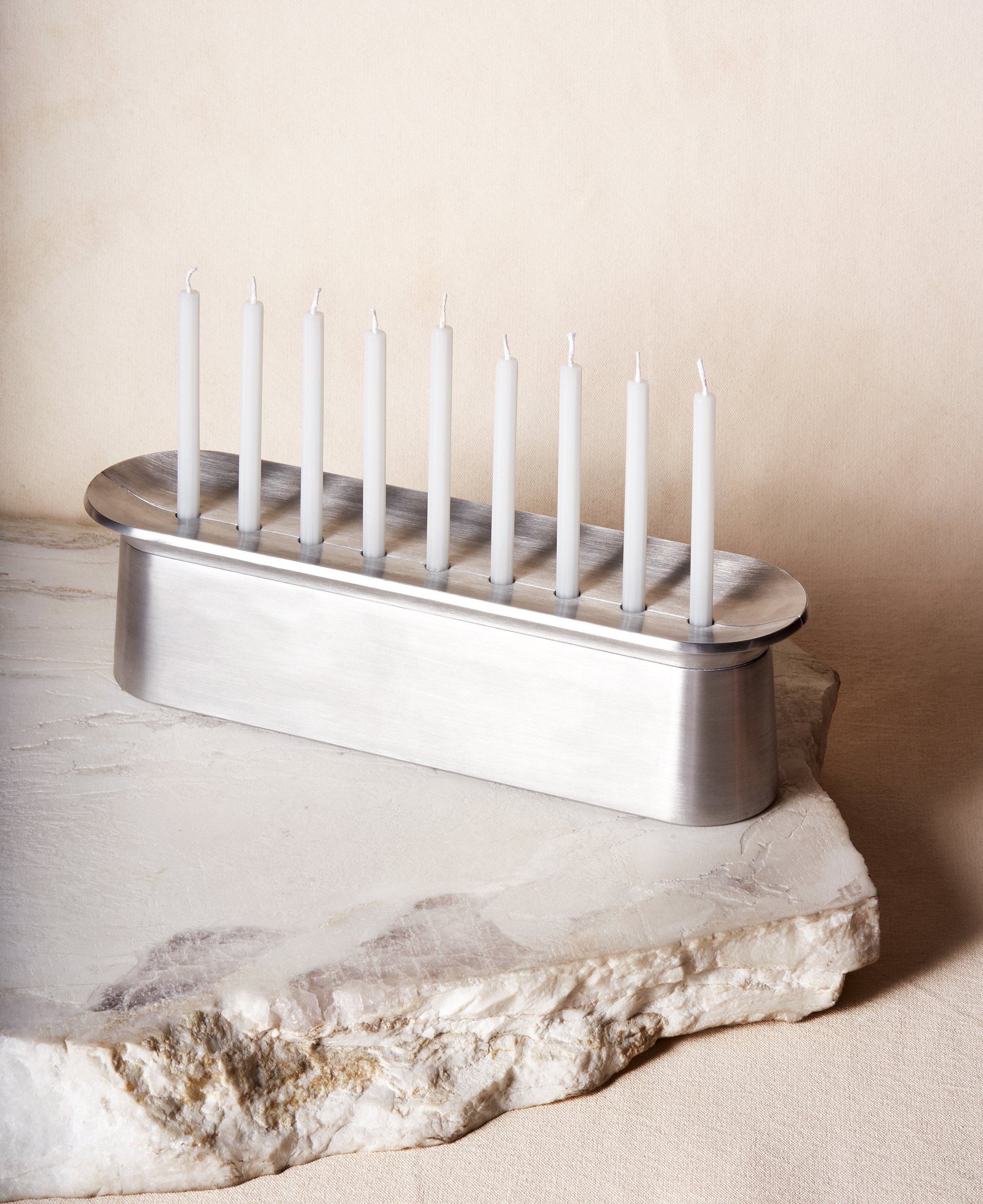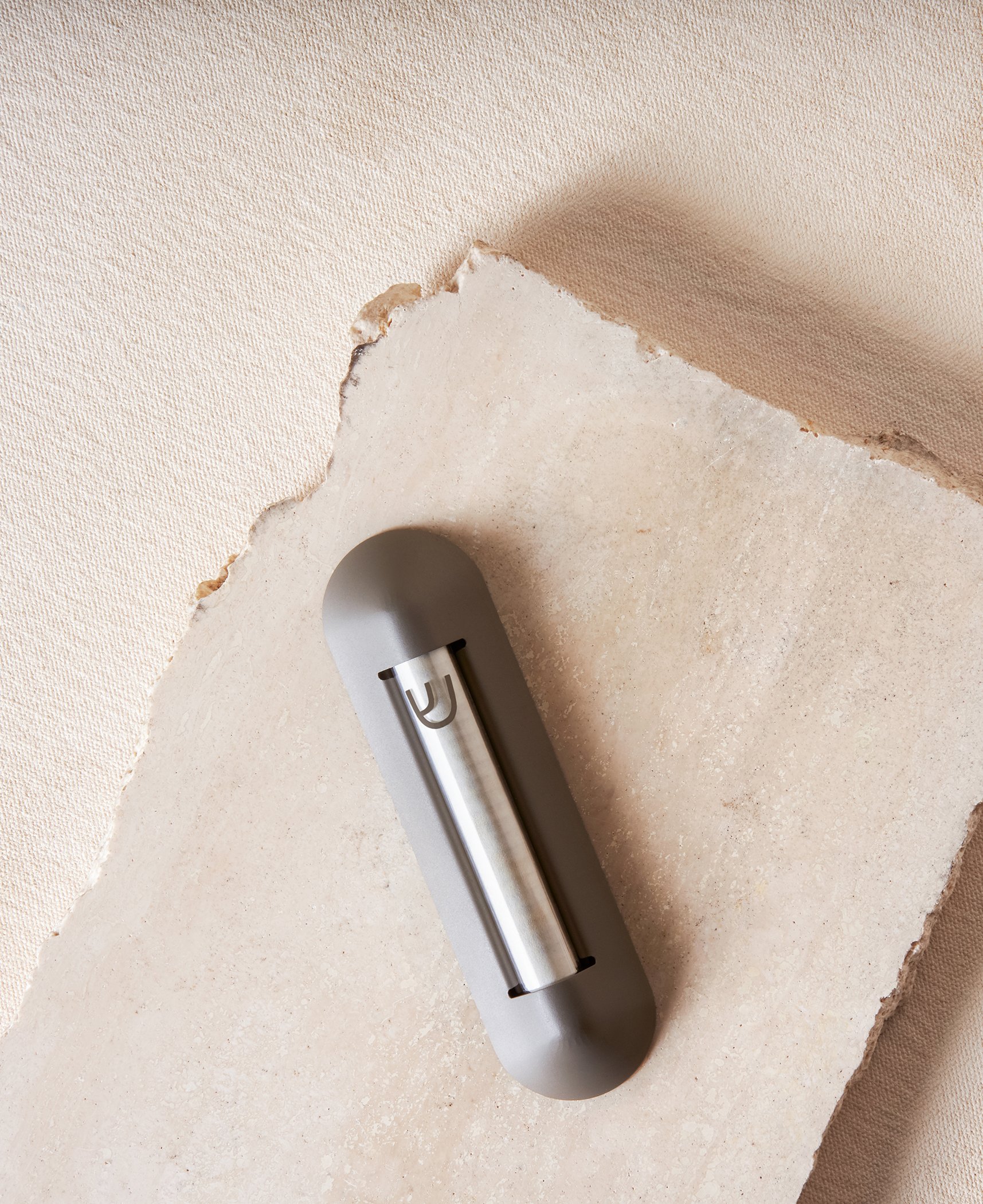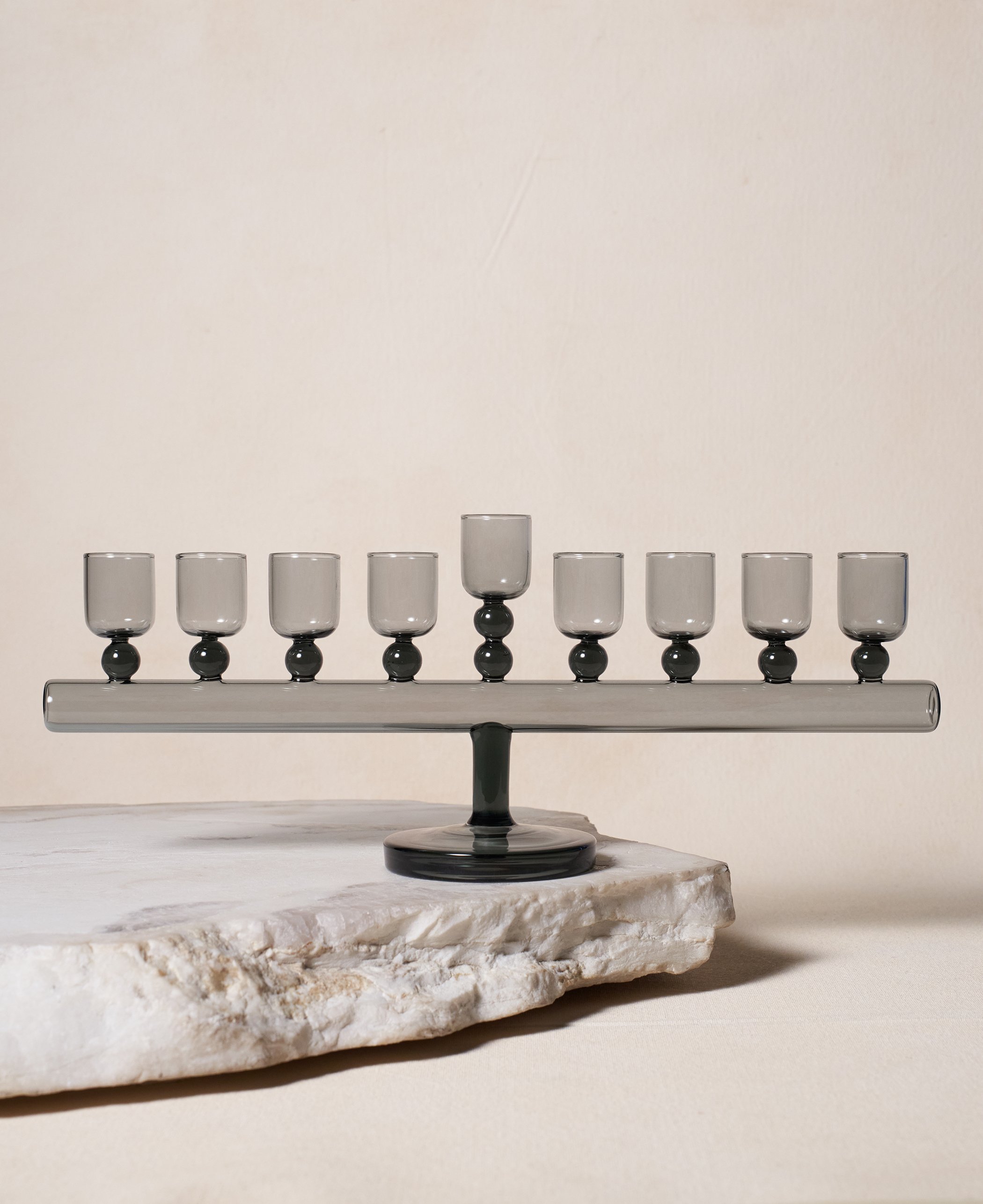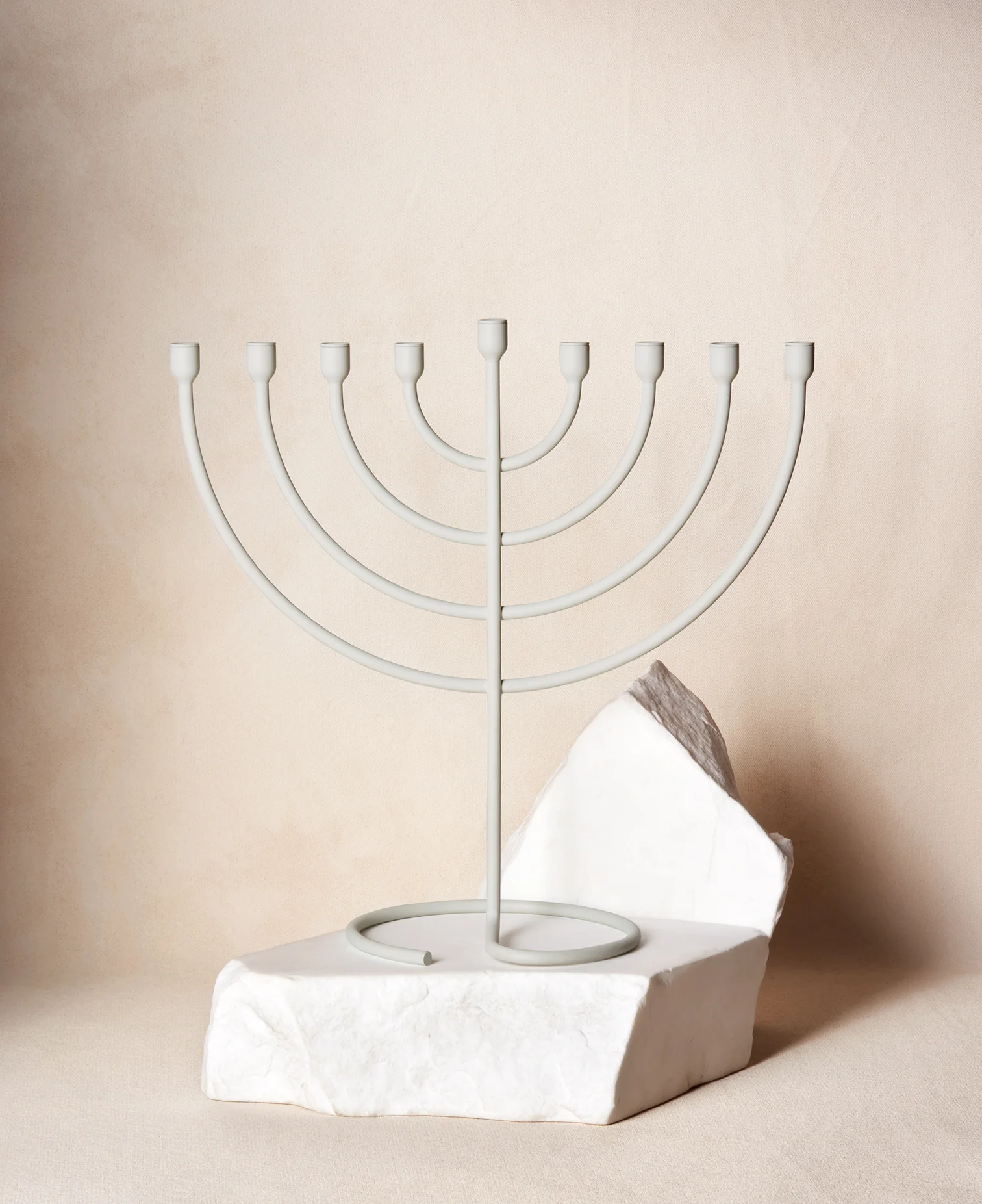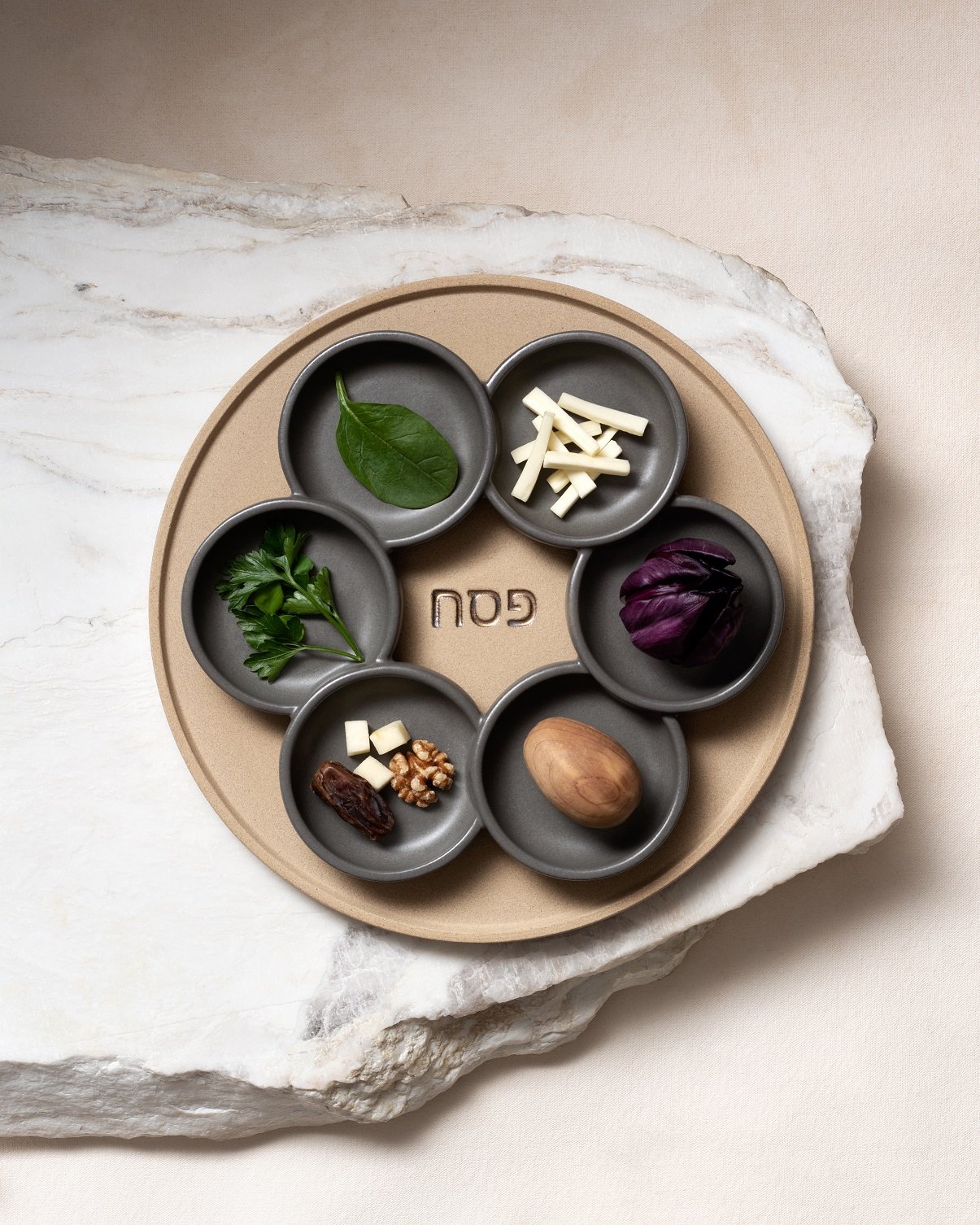How to Reinvent Judaica, with Dana Hollar Schwartz
Dana Hollar Schwartz (Photo by Justin Hollar)
As the creative force behind Via Maris, Dana Hollar Schwartz has carved a unique niche in the world of Judaica, merging the ritual objects she designs with a timeless modernist aesthetic. In this conversation with Lindsay LeBoyer, Schwartz takes us through her creative process, the influence of her art collector father, and how her family's love for art shaped her approach to design. With Via Maris, Dana Hollar Schwartz is reinterpreting traditional objects for the present era, making them relevant to a new generation of observers.
Lindsay LeBoyer: What kind of role did art play in your life growing up?
Dana Hollar Schwartz: I grew up with an art collector father and was surrounded by art within my home, but it was also something that my family did on the weekends. I sort of grew up on the gallery floors. I have a lot of memories of, you know, coloring on those concrete floors as a child. I think my family really exposed me to art and the meaning behind art. Every time my father would collect a new piece, and it would arrive in our home, we'd have conversations about, like, why is this important? Why do we have this? What does it mean? What do you see? It taught me to see things not in a different way, but in a way that I wasn't necessarily exposed to in school or from my peers. So art has always been important to me. It really is the world's language in so many ways, and it lives forever.
LL: Did your dad have a particular focus as a collector?
DHS: It’s changed a number of times, but when I was growing up my dad had a real focus on contemporary photography. I still love photography. You can talk about so many different forms of art, whether it be illustration, painting, sculpture, or video, but photography allows you to have real conversations about when something was taken and who took it. There's just so much that can come from the photographer’s lens.
I also married a photographer, and he’s the photographer for Via Maris. If you look at my Instagram account, I'm so inspired by photography. It's something that I have always wanted to kind of rescue, if that makes sense. When I started my research for Via Maris, I was doing a lot more research about Judaism and Jewish culture, and a lot of it was through photography. I think it’s one of the art forms that's really strong in Jewish culture. We have a lot of photographers.
Teens from the Jewish Agency Youth Center in Riga, Latvia, 2000. (Photo by Edward Serotta)
LL: Let’s talk about your research as it relates to the design process. Aside from working with a product designer, how do your designs come to be? Do you think about a specific piece of Judaica that you need, or do you imagine a form and then try to translate it into an object?
DHS: I think mostly about what people really need. I've always said I'm not looking to make 100 different styles of Judaica. I'm really trying to narrow down on the pieces that people actually buy, use and display so that I'm not creating more in the world in terms of waste. A lot of people email me ideas. For example, people are always asking me to make dreidels. I don't know, though, if there are enough adults in the world that want to buy dreidels, so I always sort of shied away from them. We'll see, maybe over time I can land on something. I'm also always trying to think about whether I can do it—’better’ is not the word—but can I put my own stamp on it? I think the wooden dreidels that are 99 cents are amazing. So what would I do that could make them ‘so much better’? There are also some amazing vintage traders out there. So if you're into dreidels, that's a great place to source vintage because you can get a one-off dreidel. I think vintage is great.
LL: I could imagine the right dreidel acting as a kind of sculpture, in a way. So many of your pieces seem to do that, like the Trace Chanukiah. I keep mine on my bookshelf next to a plant, and I get compliments on it all year long. These aren’t just Judaica items, they are objects that can also stand on their own, so it makes total sense that you approach your design process with such specificity. As you said earlier, art teaches you that an object exists for a reason, and I think that comes through in your designs. I'm curious if you've ever had a design problem that you had to solve. Have you ever wanted to make something and been like, well, how do I do this? Are there any interesting stories like that?
DHS: All the time. When I embark on a new product, I’m really starting from the beginning and seeing what’s possible. I can tell you, for example, I have a new product coming out for Passover. It’s essentially a plate to accommodate matzah. It started with a bit of an issue, which is how I approach design and think about products. So for me, my matzah on the table is always a little bit of a pain point. It's usually square, even though you can get beautiful round matzah. Most people get the square but do not have square plates. So what ends up happening is you place it on a round plate and the corners hang off, and there's kind of this air bubble at the bottom because it doesn’t rest flat. That was the beginning of knowing there's something that can be improved upon, and then I had to figure out how to do that in a very beautiful way. So that's an example of something that really needed, I think, a solution.
Another example is the Block Chanukiah, which was one of the first styles we offered alongside the Trace. The Block was really my answer to candle wax on your table. I think we've all grown up putting aluminum foil under our chanukias, or putting it on a plate or something. And to me, it's just such an eyesore. The classic menorah shape is so stunning that you know, you have to do that. But when it comes to really utilizing it and thinking, what could you do that maybe you wouldn't have to worry about it dripping? Or what's a super, super user friendly object? So with some of the items it started as not being the most user friendly and then trying to improve upon that, and with others it’s making something that’s just supposed to be beautiful.
Trace Chanukiah by Via Maris - Shot by Justin Hollar
LL: Just to kind of turn to the aesthetics and the visuals, are there any sources that you go to for inspiration? The Block Chanukiah, to me, kind of reduces the menorah down to its crudest form, and I feel like there are so many art movements that take that idea—taking something that could be more ornate or maybe more realistic—and stripping it down to its essence. Are there any particular movements or artists that resonate with you for that reason?
DHS: There's not one artist I would say. I certainly look at all the archives of the major Jewish museums around the world. Most of them have their collections available online, and it's an amazing resource if you ever have time to just flip through them. I also collect vintage books, and I have a number of relationships with booksellers who source incredible Jewish vintage books. So that's where I find a lot of my imagery. It's where I find a lot of my historical information as well, just stuff that's not readily available online. Those are my two resources, I would say. And then when it comes to the forms themselves, there isn't a particular movement that anything follows. I've tried, I think, to keep things simple enough, like with the Trace Chanukiah, what color do you have?
LL: I have the whitish-blue one.
DHS: Yeah– ‘cloud.’ What was cool about that object, for example, is that it's super, super simple. It's called the Trace because it looks like it could be traced from a history book. It’s actually really complex to make, but that's where the name comes from. There was something so beautiful to me about a form that can be very different depending on the color. If it's that off white cloud or a sunny yellow, or a deep blue or a terracotta-ish pink, it becomes a different object, and it really can suit so many different people. It's also simple enough that it's going to look great in 20 or 50 years. I really do want these items to be passed down. That’s what Judaica is meant for.
LL: Do you think about how your designs will represent this era? It seems like there is a movement happening in contemporary Judaica. Do you ever think about what your designs will mean in a few generations?
DHS: I don't think about it necessarily. Part of why I wanted to do something that's a bit more contemporary, aside from aesthetics, is because there's a lot of power in choosing to buy something or covet something that's for now, especially for young people. There's power in saying, ‘I'm Jewish, this is my style, I'm gonna buy something for myself now.’ There's a lot of talk these days about being a proud Jew. We all feel proud. I more want to put out the message of being an engaged Jew; someone who is just constantly making decisions for themselves to be engaged with Judaism. It doesn't have to mean buying Judaica, but I do think there’s power in that, and I certainly hear it from customers. People will say, ‘I had no idea I needed a chic menorah, but now I have one.’ To me that's a huge win, because you've awoken something in that person. I always say Via Maris is a not-on-the-nose response to the climate. It means a lot more than just what you see.
LL: We’re at this moment in time when so many people are becoming more engaged with their Judaism, and visual objects can be an accessible entry point to that, for sure. Whether or not you're already engaged in the rituals, to make something your own and make Judaism your own is a big deal. Thinking in terms of Jewish material culture and its history, Via Maris captures this shift towards a more personal approach to Judaism, or a kind of post-traditional yearning for tradition. Maybe that’s already been a thing in Israel, but at least here it feels new.
Block Chanukiah by Via Maris - Shot by Justin Hollar
DHS: The Israeli relationship to Judaica is very different from anywhere in the diaspora. When you talk to Israelis, they don't totally get it in the same way, and I think that's because there's a privilege of being around it. They're not a minority. We have a totally different relationship outside of Israel to Judiacia. I used to joke that when you’d go to someone’s house growing up, you’d kind of scan their house and ask yourself, ‘Are they friendly?’ You’d go, okay, Ottolenghi cookbook in the kitchen. You’d start to look for these little clues. To me, Judaica obviously was like, ding ding ding. It’s saying you’re among friends. You’re in a home that has the same values and morals as you. You can talk to these people. They’re your family. So I always felt like Judaica just being displayed within the home was so powerful. It's what separates my home from everybody else's. Not just the mezuzah on the door, but when you walk in and there's a menorah, it's an incredible symbol. I think the menorah, a chanukiah, is probably one of the oldest design objects in the world. I've never been able to find someone who can verify that, but I can't think of that many objects aside from tools that our ancestors from 2,000 years ago would recognize and know exactly what to do with. That’s why I think the Trace is such a powerful chanukiah. It’s the one people would instantly know. It's continuously been designed like that and used in the exact same way for centuries. I cannot think of anything else that is unbroken in what it's for, what it represents and how to use it.
Glass Chanukiah by Via Maris – Shot by Justin Hollar
LL: Yeah, I never thought about it that way. It’s really incredible.
I want to move on to my final question, which is about the Via Maris newsletter. First of all, it’s amazing. We at Havurah are big fans of it. I just love the fact that you have a newsletter and that aside from promoting your products, you do interviews and art and culture recommendations. So I wanted to ask, what’s on your radar right now? Are there any upcoming museum shows you hope to visit?
DHS: The Jewish Museum in New York has a show on the designer of Chloé, who was Jewish, that I have yet to see. That's the first thing that comes to mind. I do those newsletters because I was always personally looking for activities that weren’t so on the nose Jewish. I want to go and see, like, a Jewish photographer's perspective about life! We want the culture. The topic doesn’t even need to be Jewish, I just want to support these figures who are important and who are Jewish, and so certainly their perspective is Jewish.
LL: I actually went and saw a Ruth Orkin photography show because you had recommended it. It was at Fotografiska in Manhattan, and it was fantastic.
DHS: Oh yeah, that was maybe around this time last year? It takes a lot of research to put those newsletters together. It's not an easy Google. I was always looking for things to do on the weekends that had a Jewish link but we're also just normal things, like art, theater, books and TV, just the things that are in our life. I thought, how do I ensure that there's support for that? And speaking of museums, I'm always trying to get people to go and visit Jewish museums and go support the Jewish artists that non-Jewish museums are showing. There's so much power in that. Like, sell those shows out! I will say for the Jewish museums around the world, they really preserve a piece of us. It's really important to visit. Even if it's just a visit—you don't need to donate. A lot of them even have days that are free. Just simply going and being a patron I think is super, super important. Everyone should be visiting Jewish museums, especially right now. You know, they have Dead Sea Scrolls! They literally have everything. They have photo archives that you wouldn't believe. They really do have our most important pieces.
LL: Yeah, that's beautiful. I’ve actually just come up with another question. If you could see a Via Maris design in any museum in the world, which would it be?
DHS: Probably the Jewish Museum in New York because I'm based here. They were actually the first store to pick me up when I launched, so I will always be super appreciative of them. I think they do such incredible work and such incredible shows. It's not just in the last decade, but you can look back at some of the shows they were doing in the 60s and the 70s. They were pioneering so many artists. I just have so much respect for what they do.





